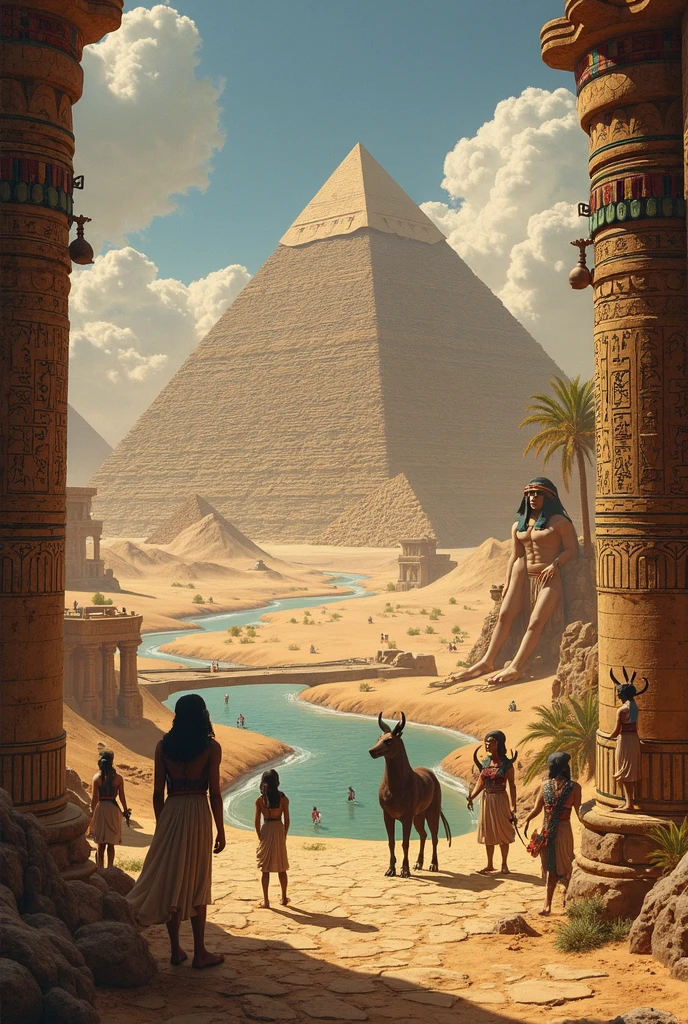Cherokee Mythology: The Sacred Stories of the Ancients
The rich tapestry of Cherokee mythology is filled with powerful deities, legendary creatures, and profound teachings. Among its most revered figures is Selu, the Corn Mother, whose story intertwines with themes of sustenance, sacrifice, and the origins of agriculture. Alongside her, characters like Kanati, the Great Hunter, and the fearsome Uktena shape the spiritual landscape of the Cherokee people.
The Legend of Selu: The Corn Mother
In Cherokee mythology, Selu is a central figure representing fertility, nourishment, and the origin of corn. According to legend, she was the wife of Kanati and the mother of two sons. Her name translates to “corn,” and her body was said to produce maize, beans, and other essential crops. The story of Selu teaches the importance of respecting nature and the sacred bond between humans and the earth.
Key Elements of Selu’s Story
- Selu provided food by rubbing her body, producing corn and beans.
- Her sons spied on her, misunderstanding her magic, leading to her death.
- From her body grew the first cornfields, ensuring the survival of the Cherokee people.
Kanati: The Great Hunter
Kanati, meaning “The Lucky Hunter,” is another pivotal figure in Cherokee mythology. As the husband of Selu, he was responsible for providing meat to his family. His hunting skills were unmatched, but his story also carries lessons about curiosity and consequences, as his sons’ actions led to the release of dangerous animals into the world.
| Deity | Role | Symbolism |
|---|---|---|
| Selu | Corn Mother | Fertility, Agriculture |
| Kanati | Great Hunter | Provision, Balance |
| Uktena | Serpent Spirit | Danger, Hidden Knowledge |
The Uktena: A Serpent of Power and Peril
Among the most feared beings in Cherokee mythology is the Uktena, a giant serpent with horns and a diamond-shaped crest on its forehead. This creature embodies both danger and hidden wisdom. Warriors and shamans sought its power, but encountering the Uktena was a test of courage and purity.
Characteristics of the Uktena
- Giant, horned serpent with shimmering scales.
- Possesses a magical jewel called the Ulûñsû’tî.
- Symbolizes both destruction and esoteric knowledge.
The Moon in Cherokee Mythology
The Moon holds a special place in Cherokee mythology, often associated with timekeeping, feminine energy, and spiritual guidance. Many rituals and ceremonies were timed according to lunar cycles, emphasizing the deep connection between the Cherokee people and celestial bodies.
The Seven Clans of the Cherokee
The Cherokee society was traditionally divided into seven Clans, each with distinct roles and responsibilities. These Clans fostered unity and ensured the balance of social and spiritual duties within the tribe.
| Clan Name | Symbol | Primary Role |
|---|---|---|
| Wolf | Wolf | Protectors |
| Deer | Deer | Hunters |
| Bird | Bird | Messengers |
| Long Hair | Hair | Peacekeepers |
| Wild Potato | Plant | Gatherers |
| Blue | Panther | Medicine |
| Paint | Paint | Artisans |
Additional Resources on Cherokee Mythology
For those interested in delving deeper into Cherokee mythology, here are some valuable resources:
Explore more fascinating articles on mythology and culture, and don’t forget to follow us on facebook.com/zatiandrops for daily updates!
The First Fire: A Cherokee Creation Tale
One of the most captivating stories in Cherokee mythology explains how fire came to the people. According to legend, the world was once cold and dark until the animals held a council to retrieve fire from a distant island guarded by the Thunder Beings. The tiny Water Spider succeeded where larger animals failed by weaving a bowl from her thread to carry a burning coal—a testament to ingenuity and perseverance.
Key Participants in the First Fire
- Raven – Burned black by the flames after failing.
- Screech Owl – Blinded by smoke, explaining its red eyes.
- Snake – Crawled too close and lost its legs.
- Water Spider – The unlikely hero who brought fire safely.
The Little People: Mystical Protectors
In Cherokee folklore, the Yunwi Tsunsdi (Little People) are invisible spirits who dwell in forests and caves. These beings, no taller than a child, are both mischievous and benevolent—punishing those who disrespect nature while aiding the lost or injured. Shamans often sought their guidance, and parents warned children not to wander alone lest they encounter these elusive guardians.
| Type of Little People | Behavior | Associated Locations |
|---|---|---|
| Rock People | Playful tricksters | Mountain caves |
| Laurel People | Healers | Forest thickets |
| Water People | Dangerous if provoked | Rivers and springs |
The Thunder Beings: Storm Spirits
The Ani Hyuntikwalaski (Thunder Beings) are celestial warriors who ride lightning bolts and wield thunder as weapons. Revered and feared, they purify the earth with storms and punish wrongdoing. Cherokee rituals often included offerings to appease them, especially during planting seasons. Their battles with the Uktena symbolize the eternal clash between chaos and order.
Symbolism of Thunder Beings
- Represent justice and natural balance.
- Associated with the Directional Winds (North, South, East, West).
- Their voices (thunder) are considered divine messages.
The Origin of Disease and Medicine
A profound Cherokee myth explains how diseases emerged when animals, angered by human hunting excesses, created illnesses to retaliate. The Plants, sympathetic to humans, offered remedies—leading to the birth of herbal medicine. This story underscores the Cherokee belief in reciprocity with nature and the sacred role of healers (Didahnvwisgi).
| Animal | Disease Caused | Plant Antidote |
|---|---|---|
| Deer | Rheumatism | Willow bark |
| Bear | Nightmares | Sage |
| Snake | Fear | Ginseng |
The Trail of Tears: A Mythological Perspective
While historically documented, the forced removal of the Cherokee in 1838 also resonates in their oral traditions. Some elders speak of prophetic dreams by shamans foretelling the “Trail Where They Cried,” interpreted as a test of resilience. Post-exile myths emerged, like the Wandering Nunnehi—immortal spirits who guided the displaced, reinforcing cultural continuity.
Survival Symbols in Post-Removal Lore
- Nunnehi – Invisible protectors who aided travelers.
- Evening Star – A celestial guide for the lost.
- Ghost Dance – Rituals to reconnect with ancestral lands.
Cherokee Star Lore: Constellations and Omens
The Cherokee mapped the sky with unique constellations, blending astronomy and myth. The Pleiades (Ani Tsutsa) were seven boys who danced into the heavens, while Orion’s Belt (The Hand) symbolized a hunter’s weapon. Celestial events like eclipses were seen as moments when the Great Spirit renewed the world’s balance.
Notable Cherokee Constellations
- Long Man (Milky Way) – The path souls travel after death.
- Bear’s Lodge (Corvus) – Where bears ascended to the stars.
- Fire Dragon (Scorpius) – A warning of summer’s end.
Rituals and Ceremonies
Cherokee spiritual life revolved around ceremonies aligning with natural cycles. The Green Corn Ceremony, held at harvest, celebrated renewal with fasting, dances, and forgiveness rituals. Meanwhile, the Booger Dance used masks to mock colonizers, blending humor with resistance—a practice still revived today.
| Ceremony | Purpose | Key Elements |
|---|---|---|
| Green Corn | Purification | New fire, fasting, stomp dances |
| Great New Moon | Thanksgiving | Feasting, storytelling |
| Booger Dance | Social satire | Masks, comedic skits |
Modern Interpretations and Revival
Today, Cherokee artists and writers reimagine these myths through contemporary lenses. Novelists like Traci Sorell adapt traditional stories for young readers, while cultural centers preserve oral traditions. The Eastern Band of Cherokee hosts annual festivals like the Cherokee Indian Fair, where myths come alive through dance and craft.
Ways Myths Are Kept Alive
- Storytelling events – Elders pass tales to youth.
- Art installations – Sculptures of Uktena or Selu.
- Language apps – Teaching Cherokee through myth-based lessons.
Explore more fascinating articles on mythology and culture, and don’t forget to follow us on facebook.com/zatiandrops for daily updates!
The Spirit of the River: Unole and the Water Beings
In Cherokee mythology, rivers and streams were inhabited by Unole, powerful water spirits who controlled the flow and purity of waterways. These beings demanded respect—polluting or disturbing their homes could bring misfortune. Fishermen often left small offerings of tobacco or cornmeal to ensure safe passage and bountiful catches. The Unole were also believed to teach healing through sacred springs, where medicine men gathered herbs.
Types of Water Spirits
- River Guardians – Protectors of major waterways like the Tennessee River.
- Spring Spirits – Healers residing in mineral-rich springs.
- Storm Bringers – Spirits who controlled floods and droughts.
The Twin Heroes: Stoneclad and Flint
The Cherokee creation story includes the Dangerous Twins, known as Stoneclad (Tsvdigewi) and Flint (Dâyuni’sï). Born from a woman who ingested magic pebbles, they embodied duality—Stoneclad brought structure to the world, while Flint introduced fire and tools. Their battles with monsters like the Great Buzzard (who carved valleys with its wings) shaped the Appalachian landscape.
| Twin | Gifts to Humanity | Symbolic Meaning |
|---|---|---|
| Stoneclad | Mountains, stability | Endurance |
| Flint | Fire, arrowheads | Innovation |
The Great Buzzard’s Flight
When the earth was soft and new, the Great Buzzard (U’tlûñ’ta) flew low over the land, its tired wings dragging through the mud. Where its wings struck, valleys formed; where they lifted, mountains rose. This explains why Cherokee country has alternating ridges and hollows. The story warns against arrogance—the buzzard’s pride in its strength forever marked the land with chaos.
Geographic Features Linked to the Myth
- Great Smoky Mountains – Formed by the buzzard’s upward wingbeats.
- Tennessee River Valley – Created by a single sweeping wingtip.
The Cherokee Vampire: The Raven Mocker
Among the darkest figures in Cherokee lore is the Kalona Ayeliski (Raven Mocker), a witch who steals lives. By night, it transforms into a raven or fiery skeleton, swooping to siphon the dying’s last breaths. Medicine men wore ulûñsû’tî (crystal) amulets for protection, and owl feathers were placed near the sick to scare the creature away.
| Signs of a Raven Mocker | Defenses Against It |
|---|---|
| Unexplained rushing wind | Sacred cedar smoke |
| Screeching at midnight | Spirit masks |
The Sacred Number Seven
The number seven holds deep significance in Cherokee cosmology, reflecting balance:
- Seven directions (North, South, East, West, Above, Below, Center)
- Seven clans
- Seven levels of purity in ritual preparation
- Seven Cherokee festivals per year
The Legend of the Strawberry Moon
When the first man and woman quarreled, the woman left in anger. The Great Spirit made strawberries grow where she walked—their sweetness made her pause, and her husband caught up to reconcile. Thus, the Strawberry Moon (A-ni-s-guti) in June became a symbol of forgiveness. During this lunar phase, disputes were settled, and marriages renewed.
Cherokee Moons and Their Meanings
| Moon Name | Season | Cultural Significance |
|---|---|---|
| Cold Moon (Unolvtani) | December | Storytelling season |
| Planting Moon (Anisguti) | April | Blessing seeds |
| Harvest Moon (Duliidsdi) | September | Giving thanks |
The Eternal Flame: Atagâ’hï
The Cherokee kept a perpetual sacred fire (Atagâ’hï) in their council houses, symbolizing the tribe’s spirit. According to myth, this fire was originally stolen from the Thunder Beings and had to be ritually rekindled each year using friction from sycamore wood. Extinguishing it meant disaster—a belief echoed during the Trail of Tears, when embers were carried west in clay pots.
Rules of the Sacred Fire
- Only Beloved Women could tend it.
- No metal tools could touch the flames.
- Ashes were buried, never scattered.
Cherokee Ghost Stories: The Night Visitors
Cherokee ghost lore speaks of Asgina, spirits who walk at night. Unlike malevolent ghosts, these were often ancestors returning to deliver warnings or comfort. Families set out hickory nut soup (a spirit favorite) during the Feast of the Dead. A moved bowl meant the visitor had accepted the offering.
Additional Resources
For further exploration of these lesser-known tales:
Explore more fascinating articles on mythology and culture, and don’t forget to follow us on facebook.com/zatiandrops for daily updates!
The Sacred Cedar: Tree of Life in Cherokee Belief
In Cherokee mythology, the cedar tree (a-tsi-na) holds immense spiritual power. Revered as a purifier and protector, its smoke was used in ceremonies to ward off evil spirits. According to legend, the first cedar sprouted where a drop of blood from the Uktena fell, imbuing it with protective qualities. Warriors carried cedar twigs into battle, and mothers placed boughs in cradles to safeguard infants.
Uses of Sacred Cedar
- Cleansing rituals – Burning cedar needles for purification
- Medicine bundles – Wrapping healing herbs in cedar bark
- Spiritual armor – Wearing cedar necklaces for protection
The Origin of the Blackberry: A Lesson in Humility
A lesser-known Cherokee tale explains how blackberries came to have thorns. The story tells of Grandmother Spider challenging the arrogant Sun to a weaving contest. When the Sun’s pride caused him to burn Grandmother Spider’s perfect web, the Creator transformed the remnants into blackberry vines—the thorns serving as eternal reminders against vanity.
| Plant | Mythological Origin | Moral Lesson |
|---|---|---|
| Blackberry | Grandmother Spider’s burned web | Humility over pride |
| Pine | Needles from the Moon’s hair | Everlasting wisdom |
The Dance of the Seasons: Cherokee Cosmology
Cherokee myths describe the changing seasons as a celestial dance between Summer (a radiant woman) and Winter (a stern old man). Their eternal struggle creates the cycle of growth and dormancy. The Spring Equinox marks Summer’s temporary victory, celebrated with the First New Moon of Spring ceremony, while Winter’s return was honored through storytelling during the Long Night Moon.
Seasonal Deities and Their Attributes
- Summer – Wears a crown of flowers, carries a basket of crops
- Winter – Cloaked in icicles, bears a staff of frozen oak
- Spring – A youth scattering seeds from a deerskin pouch
- Autumn – A matron with a blanket of falling leaves
The Talking Leaves: Sequoyah’s Mythic Inspiration
While not ancient mythology, the story of Sequoyah creating the Cherokee syllabary in the early 1800s took on legendary qualities. Some accounts claim he was visited by spirit beings who showed him “talking leaves” (written words). Others say he discovered the symbols in the patterns of spider webs and bird tracks, continuing the Cherokee tradition of learning from nature.
| Natural Inspiration | Cherokee Syllabary Character | Sound Represented |
|---|---|---|
| Bird’s footprint | Ꭰ | “a” as in father |
| Ripple in water | Ꮉ | “ma” |
The Legend of the Spearfinger Witch
One of the most terrifying Cherokee figures is U’tlun’ta (Spearfinger), a stone-skinned witch with a sharp, elongated finger she used to stab victims and consume their livers. She could mimic loved ones’ voices to lure prey and was only vulnerable at her heart—a small, fleshy spot beneath her left arm. This tale served as a warning about deception and stranger danger.
Defenses Against Spearfinger
- Answering calls only after the third attempt
- Carrying dried ginseng root as protection
- Singing the Spearfinger Song when traveling alone
The Creation of the Milky Way
Cherokee star lore includes a beautiful explanation for the Milky Way (Gili Ulvsgedi). When the world was young, a dog stole cornmeal from the people. As he fled upward, the meal spilled from his mouth, creating the starry path. This connects to the practical tradition of Cherokee farmers leaving a handful of cornmeal at field edges for spirit dogs—ensuring good harvests.
The Four Sacred Colors
Cherokee ceremonial life revolves around four sacred colors, each representing cardinal directions and spiritual concepts:
- East (Red) – Success, triumph
- North (Blue) – Defeat, trouble
- West (Black) – Death, the spirit world
- South (White) – Peace, happiness
Explore more fascinating articles on mythology and culture, and don’t forget to follow us on facebook.com/zatiandrops for daily updates!


